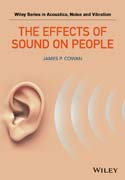
Provides a summary of current research results on the physiological and psychological effects of sound on people Covers how the operation of the hearing mechanism affects our reactions to sounds Includes research results from studies on noise sources of public concern such as transportation, public utility, and recreational sources, with emphasis on low frequency sound and infrasound Covers sounds that affect some but not others, how sounds can be controlled on a practical level, and how and what sounds are regulated Includes coverage of both positive and negative effects of sound INDICE: List of Figures .List of Tables .About the Author .Series Preface .Preface .Chapter 1 Acoustic parameters .1.1 Introduction .1.2 Sound generation .1.2.1 Frequency .1.2.2 Wavelength .1.3 Sound propagation .1.3.1 Unimpeded divergence .1.3.2 Impeded propagation .Reflection .Refraction .Diffraction .Diffusion .1.3.3 Sound behavior indoors .Echo .Room modes .Reverberation .1.3.4 Sound behavior outdoors .Atmospheric absorption .Atmospheric refraction .Ground effects .Vegetation effects .Chapter 2 Sound description .2.1 Introduction .2.2 The decibel scale .2.3 Frequency weighting networks .2.3.1 Loudness .2.3.2 Weighting scales .2.4 Frequency band analysis .2.4.1 Noise by color .2.5 Common sound descriptors .2.5.1 Environmental descriptors .2.5.2 Sound propagation in terms of sound levels .Divergence .Refraction and diffraction .Reverberation .Chapter 3 Sound perception .3.1 Introduction .3.2 Human hearing apparatus and mechanism .3.2.1 Outer ear .3.2.2 Middle ear .3.2.3 Inner ear .3.2.4 Signal processing in the brain .Localization .Masking and audibility .3.2.5 Vestibular system .3.3 Alternate sound perception mechanisms .3.3.1 Bone conduction .3.3.2 Cartilage hearing .3.3.3 Tinnitus .3.34 Electromagnetic hearing .3.4 Hypersensitivities .3.4.1 Hyperacusis/misophonia .3.4.2 Electrohypersensitivity .3.5 Low frequency and infrasound perception .Chapter 4 Physiological effects of sound exposure .4.1 Introduction .4.2 Body resonance and damage potential .4.3 Hearing loss .4.3.1 Presbycusis .4.3.2 Noise–induced hearing loss .4.3.3 Hearing loss from illness or agents .4.4 Cardiovascular disease .4.4.1 Hypertension .4.4.2 Ischaemic diseases .4.5 Vibroacoustic disease .4.6 Low frequency noise concerns .4.7 Infrasound concerns .Chapter 5 Psychological effects of sound exposure .5.1 Introduction .5.2 Annoyance .5.3 Stress .5.4 Sleep disturbance .5.5 Learning disabilities .5.5.1 Cognitive development/school performance .5.5.2 Office/occupational .5.6 Emotional effects .Chapter 6 Sound sources associated with negative effects .6.1 Introduction .6.2 Transportation sources .6.2.1 Roadway .6.2.2 Aircraft .Fixed wing .Rotary wing .6.2.3 Rail .6.3 Industry and utilities .6.3.1 Power plants .6.3.2 Wind farms .6.3.3 Electrical power systems .6.4 Personal/recreational sources .6.4.1 Firearms .6.4.2 Public performances .6.4.3 Toys/ personal listening devices .6.4.4 Appliances/tools .6.5 Hums .6.6 Acoustic weapons .Chapter 7 Positive effects of sound .7.1 Introduction .7.2 Music psychology .7.3 Sound therapies .7.4 Natural sources/soundscapes .7.5 Using sound to influence people .Chapter 8 Sound control and regulation .8.1 Introduction .8.2 Sound control fundamentals .8.2.1 Absorption .8.2.2 Transmission control .8.2.3 Partial barriers .8.2.4 Cancellation .8.2.5 Control at the source .8.2.6 Control in the path between the source and listener .8.2.7 Control at the listener .Acoustic privacy .8.3 Regulations and guidelines .8.3.1 Occupational .8.3.2 Environmental .National .Local .8.4 Current and future research .Glossary .Index
- ISBN: 978-1-118-89570-2
- Editorial: Wiley–Blackwell
- Encuadernacion: Cartoné
- Páginas: 300
- Fecha Publicación: 06/05/2016
- Nº Volúmenes: 1
- Idioma: Inglés
